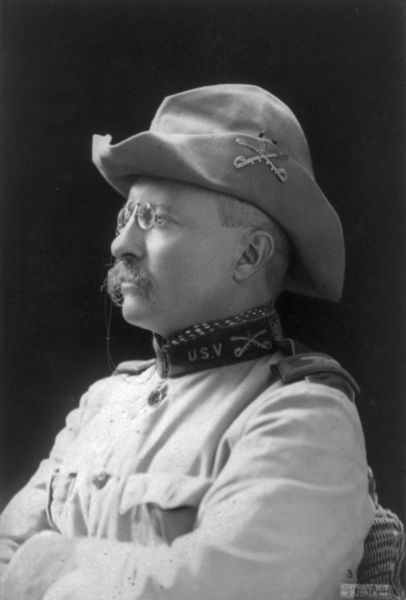Compared to his life, the death of Theodore Roosevelt was largely uneventful. After decades of robust physical exercise and constant outdoor activities, coupled with revolutionary political accomplishments and parenting six children, he died in his sleep from a heart attack.
Was Theodore Roosevelt Shot?
Yes. But the failed attempt to assassinate him – while on the campaign trail for his re-election – was not the cause of his death. On October 14, 1912 Teddy was in Milwaukee, Wisconsin. As he entered a vehicle just outside the Hotel Gilpatrick (around 8:00 p.m.) he was shot in the right side of his chest. The would-be assassin (John Schrank) was an unemployed saloon owner from New York. Unbeknownst to Teddy, he had been following him for three weeks, across eight states. After his capture, Schrank was found with a letter he had written ‘To the people of the U.S.’ detailing his reasons for shooting Roosevelt. According to the letter, he had been plagued by a dream wherein President McKinley (whose assassination in 1901 led to Teddy’s first term as president) sat up in his coffin and told him to ‘avenge’ his death by killing his successor. During his trial, Schrank also admitted he was vehemently against anyone holding presidential office three times (calling Teddy “the third termer”), which further motivated him to shoot Roosevelt. Subsequently, Schrank was found to be insane and sent to a state mental asylum for the remainder of his life.
Just after being shot, Roosevelt continued to his scheduled speech, addressing the crowd for 90 minutes. At the beginning of this speech, he made a comment about having just been shot, but insisting that “it takes more than that to kill a Bull Moose” (referring to the assassin’s failure to slow or stop him). During the speech, blood seeped through his shirt, to his suit coat, but he was determined to finish. At the conclusion of the speech, he finally agreed to go to the hospital, where x-rays showed the bullet lodged in his chest. After careful consideration, physicians and surgeons determined that attempts to remove the bullet would do more harm than good. As a result, Teddy carried the bullet to his grave.
With so much excitement and passion in life, it is ironic that Theodore Roosevelt’s death was a quiet ending for a man who was almost never quiet. After suffering through years of obesity and increasingly failing health due, in large part, to physical ailments sustained during his 1913-14 South American expedition, Teddy finally succumbed. After more than two months of extreme illness from inflammatory rheumatism, Theodore Roosevelt died in his sleep on January 6, 1919 of a coronary thrombosis (or heart attack). Actually, for Theodore Roosevelt, cause of death listed as ‘heart attack’ would have been nothing more than a cause for embarrassment (if he had been able to comment on it). Thomas R. Marshall – vice president at the time – commented on the occasion by expressing a popular sentiment about Teddy: “Death had to take Roosevelt sleeping, for if he had been awake, there would have been a fight.”
The Theodore Roosevelt Memorial, is actually an island located in the Potomac River at Washington, D.C. Established on land donated by the Theodore Roosevelt Association, it is a natural park with a plaza containing a 17-foot bronze statue of Teddy. As a tribute to his love for nature – and his fierce advocacy for conserving it – no cars or bicycles are allowed, and the only way to reach the island is by footbridge from Arlington, Virginia.
